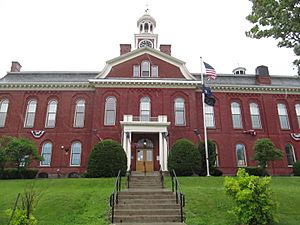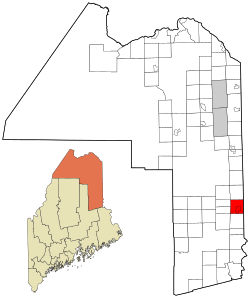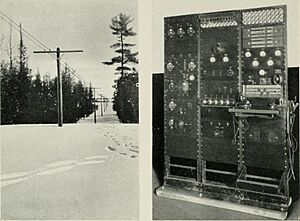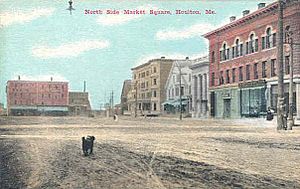Houlton, Maine facts for kids
Quick facts for kids
Houlton
|
||
|---|---|---|

Aroostook County Courthouse and Jail
|
||
|
||
| Nickname(s):
Capital of Aroostook
|
||
| Motto(s):
Valuing the past, planning for the future
|
||

Location of Houlton, Maine
|
||
| Country | United States | |
| State | Maine | |
| County | Aroostook | |
| Settled | 1807 | |
| Incorporated | March 8, 1831 | |
| Villages | Houlton Carys Mills |
|
| Area | ||
| • Total | 36.73 sq mi (95.13 km2) | |
| • Land | 36.71 sq mi (95.08 km2) | |
| • Water | 0.02 sq mi (0.05 km2) | |
| Elevation | 390 ft (119 m) | |
| Population
(2020)
|
||
| • Total | 6,055 | |
| • Density | 165/sq mi (63.7/km2) | |
| Time zone | UTC-5 (Eastern (EST)) | |
| • Summer (DST) | UTC-4 (EDT) | |
| ZIP Codes |
04730, 04761
|
|
| Area code(s) | 207 | |
| FIPS code | 23-33980 | |
| GNIS feature ID | 0582525 | |
| Website | www.houlton-maine.com | |
Houlton is a town in Maine, USA. It's the main town, or county seat, of Aroostook County. It's also right on the border with New Brunswick, Canada. In 2020, about 6,055 people lived here.
Houlton is famous for being the very end of Interstate 95 in the north. It's also the hometown of Samantha Smith. She was a young girl who became a goodwill ambassador during the Cold War. Every year, Houlton hosts the fun Houlton Agricultural Fair.
People sometimes call Houlton the "Shire Town." The sports teams at Houlton High School are even called "The Shiretowners." The Meduxnekeag River flows right through the town. The Canadian border is only about 3 miles (5 km) east of the town center. Houlton was also home to Ricker College, which closed in 1978.
The main part of the town is known as a CDP with the same name. The main office for the Houlton Band of Maliseet Indians is located here.
Contents
Houlton's History: A Look Back
Early Days and Settlement
For thousands of years, different groups of indigenous peoples lived in the Houlton area. In more recent history, these were the Maliseet people, who spoke an Algonquian language.
When Maine was part of Massachusetts, land was given to schools. The land that became Houlton was given to the Academy of New Salem, Massachusetts. Thirteen men from New Salem bought this land. However, only three of them actually moved there to settle.
After the American Revolutionary War, pioneers named Aaron Putnam and Joseph Houlton started a village. They named it after Joseph Houlton, who had moved to Maine in 1807. Maine became its own state in 1820, separating from Massachusetts.
Military Presence and Border Disputes
In 1828, the U.S. government built a military base called Hancock Barracks in the area. Houlton officially became a town in 1831.
In 1839, there was a disagreement over the border with Canada, known as the Aroostook War. Three groups of soldiers were sent to Hancock Barracks. A major named R. M. Kirby helped prevent a real shooting war. The border issue was finally solved in 1842 with the Webster-Ashburton Treaty. The Army left Hancock Barracks in 1847.
Houlton's Role in World Wars
During World War I, the U.S. Army built its first transatlantic radio intelligence station near Houlton. This station listened in on German messages, especially from their Nauen Transmitter Station. It was a very important step for U.S. intelligence. Its success led to many more long-range radio stations being built.
On January 7, 1927, AT&T started the first commercial phone service between New York and London. The AT&T Transoceanic Receiver Station was located near Houlton. It had a huge antenna, over three miles long! This station worked with a large transmitting station in New York. It received phone signals from a station in England.
In 1941, the U.S. Army built the Houlton Army Air Base right next to the Canadian border. Before the U.S. joined World War II, American pilots flew planes to this base. They couldn't fly directly into Canada because the U.S. was officially neutral. So, local farmers used their tractors to tow the planes into Canada! Canadians even closed a highway so planes could use it as a runway.
Sadly, a pilot from New Zealand, George Newall Harrison, died in 1942 when his plane crashed near the runway. He was flying a bomber to Britain. His radio operator, Henry Bordewick from Canada, also died. Both were buried in Houlton's Evergreen Cemetery. Their graves are looked after by the American Legion.
The Houlton Army Air Base closed in July 1944. A big part of it was then used as Camp Houlton, a prisoner of war camp. At its busiest, Camp Houlton held 3,700 German prisoners. These prisoners could volunteer to work. They helped local farmers harvest peas and potatoes. Farmers often found them to be good workers. The prisoners were paid a small amount of money they could spend at the base store. Camp Houlton closed in 1946. The site later became Houlton International Airport.
The Great American Eclipse
On April 8, 2024, a solar eclipse crossed the United States. Houlton was right in the path where the sun would be completely covered. The town spent two years getting ready for a three-day festival.
Even more people came than expected because of bad weather in other places. This led to a last-minute rush of visitors to Houlton. It's estimated that 20,000 people or more came! This sudden rush of tourists made the street party even more exciting. A big banner was put up saying, "The End is Here," celebrating Houlton as the eclipse's final stop. A statue of George Washington in town even got a pair of oversized eclipse glasses! People gathered all over town to watch the amazing sight. After the eclipse, there was a 7-mile traffic jam leaving town.
Geography and Climate of Houlton
Town Size and Rivers
Houlton covers about 36.73 square miles (95.13 square kilometers). Most of this is land, with a very small amount of water. The Meduxnekeag River flows through the town.
Roads and Borders
Interstate 95 ends its northern journey in Houlton. The Houlton/Woodstock Border Crossing is east of downtown Houlton, marking the end of I-95. U.S. Route 1 and U.S. Route 2 also pass through Houlton. They even share a short section of road in the town center.
Weather Patterns
Houlton has a humid continental climate. This means it has warm summers and cold, snowy winters. January is usually the coldest month. Snow can get quite deep, often reaching about 14 inches (36 cm) in February. Temperatures can range from very cold, like −41 °F (−41 °C), to very hot, like 99 °F (37 °C).
| Climate data for Houlton, Maine (Houlton International Airport) 1991–2020 normals, extremes 1948–present | |||||||||||||
|---|---|---|---|---|---|---|---|---|---|---|---|---|---|
| Month | Jan | Feb | Mar | Apr | May | Jun | Jul | Aug | Sep | Oct | Nov | Dec | Year |
| Record high °F (°C) | 58 (14) |
62 (17) |
79 (26) |
86 (30) |
96 (36) |
97 (36) |
97 (36) |
99 (37) |
93 (34) |
82 (28) |
73 (23) |
60 (16) |
99 (37) |
| Mean maximum °F (°C) | 46.1 (7.8) |
44.5 (6.9) |
53.6 (12.0) |
70.4 (21.3) |
82.6 (28.1) |
87.5 (30.8) |
89.4 (31.9) |
88.5 (31.4) |
83.2 (28.4) |
72.3 (22.4) |
61.1 (16.2) |
49.9 (9.9) |
91.6 (33.1) |
| Mean daily maximum °F (°C) | 23.2 (−4.9) |
26.3 (−3.2) |
36.0 (2.2) |
49.3 (9.6) |
63.6 (17.6) |
72.5 (22.5) |
78.1 (25.6) |
76.7 (24.8) |
68.3 (20.2) |
54.5 (12.5) |
41.3 (5.2) |
29.6 (−1.3) |
51.6 (10.9) |
| Daily mean °F (°C) | 12.9 (−10.6) |
14.8 (−9.6) |
25.5 (−3.6) |
38.6 (3.7) |
51.2 (10.7) |
60.2 (15.7) |
66.1 (18.9) |
64.4 (18.0) |
56.2 (13.4) |
44.3 (6.8) |
33.1 (0.6) |
20.9 (−6.2) |
40.7 (4.8) |
| Mean daily minimum °F (°C) | 2.6 (−16.3) |
3.2 (−16.0) |
15.0 (−9.4) |
27.9 (−2.3) |
38.9 (3.8) |
48.0 (8.9) |
54.1 (12.3) |
52.1 (11.2) |
44.0 (6.7) |
34.0 (1.1) |
24.8 (−4.0) |
12.2 (−11.0) |
29.7 (−1.3) |
| Mean minimum °F (°C) | −22.5 (−30.3) |
−20.8 (−29.3) |
−11.7 (−24.3) |
12.3 (−10.9) |
25.5 (−3.6) |
33.0 (0.6) |
41.1 (5.1) |
38.1 (3.4) |
27.7 (−2.4) |
19.1 (−7.2) |
5.1 (−14.9) |
−12.2 (−24.6) |
−25.2 (−31.8) |
| Record low °F (°C) | −41 (−41) |
−36 (−38) |
−31 (−35) |
−13 (−25) |
18 (−8) |
26 (−3) |
32 (0) |
30 (−1) |
20 (−7) |
10 (−12) |
−14 (−26) |
−34 (−37) |
−41 (−41) |
| Average precipitation inches (mm) | 2.65 (67) |
1.95 (50) |
2.67 (68) |
2.94 (75) |
3.46 (88) |
4.04 (103) |
3.63 (92) |
3.52 (89) |
3.40 (86) |
4.04 (103) |
3.61 (92) |
3.37 (86) |
39.28 (998) |
| Average snowfall inches (cm) | 22.8 (58) |
20.9 (53) |
19.0 (48) |
6.3 (16) |
0.1 (0.25) |
0.0 (0.0) |
0.0 (0.0) |
0.0 (0.0) |
0.0 (0.0) |
0.7 (1.8) |
6.5 (17) |
19.6 (50) |
95.9 (244) |
| Average precipitation days (≥ 0.01 in) | 11.4 | 9.8 | 11.0 | 12.2 | 13.4 | 13.7 | 13.0 | 11.8 | 10.7 | 12.6 | 11.7 | 12.6 | 143.9 |
| Average snowy days (≥ 0.1 in) | 11.9 | 10.7 | 8.6 | 3.7 | 0.1 | 0.0 | 0.0 | 0.0 | 0.0 | 0.8 | 4.5 | 10.4 | 50.7 |
| Average relative humidity (%) | 91 | 91 | 91 | 83 | 76 | 78 | 78 | 79 | 80 | 82 | 83 | 88 | 83 |
| Mean daily sunshine hours | 3.2 | 2.6 | 3.8 | 5.8 | 7.4 | 8.1 | 9.3 | 9.6 | 7.4 | 5.8 | 4.2 | 3.5 | 5.9 |
| Mean daily daylight hours | 9.1 | 10.4 | 12.0 | 13.6 | 15.0 | 15.7 | 15.3 | 14.1 | 12.5 | 10.9 | 9.4 | 8.7 | 12.2 |
| Average ultraviolet index | 1 | 1 | 1 | 3 | 4 | 5 | 5 | 4 | 3 | 2 | 1 | 1 | 3 |
| Source 1: NOAA (snow recorded at Houlton 5N weather station) | |||||||||||||
| Source 2: Weather Atlas (UV and humidity) | |||||||||||||
Houlton's Population and People
| Historical population | |||
|---|---|---|---|
| Census | Pop. | %± | |
| 1820 | 115 | — | |
| 1830 | 579 | 403.5% | |
| 1840 | 1,597 | 175.8% | |
| 1850 | 1,453 | −9.0% | |
| 1860 | 2,035 | 40.1% | |
| 1870 | 2,850 | 40.0% | |
| 1880 | 3,228 | 13.3% | |
| 1890 | 4,015 | 24.4% | |
| 1900 | 4,686 | 16.7% | |
| 1910 | 5,845 | 24.7% | |
| 1920 | 6,191 | 5.9% | |
| 1930 | 6,865 | 10.9% | |
| 1940 | 7,771 | 13.2% | |
| 1950 | 8,377 | 7.8% | |
| 1960 | 8,289 | −1.1% | |
| 1970 | 8,111 | −2.1% | |
| 1980 | 6,766 | −16.6% | |
| 1990 | 6,613 | −2.3% | |
| 2000 | 6,476 | −2.1% | |
| 2010 | 6,123 | −5.5% | |
| 2020 | 6,055 | −1.1% | |
Population in 2010
In 2010, there were 6,123 people living in Houlton. They lived in 2,556 households, with 1,563 of these being families.
About 30% of households had children under 18. Around 43% were married couples. The average age in Houlton was 43.2 years old. About 22% of residents were under 18, and nearly 20% were 65 or older.
Education in Houlton
Houlton High School is the public high school for students in the town.
Places to See in Houlton

Here are some interesting places to visit in Houlton:
- Amazeen House (built in 1882)
- Aroostook County Courthouse and Jail
- Aroostook County Historical & Art Museum
- Blackhawk Putnam Tavern
- Cary Library
- Edward L. Cleveland House
- Market Square Historic District
- Unitarian Church of Houlton
- Walter P. Mansur House
Famous People from Houlton
Many notable people have connections to Houlton:
- Charles P. Barnes: A former Chief Justice of the Maine Supreme Judicial Court.
- Ralph Botting: A pitcher for the California Angels baseball team.
- Michael E. Carpenter: A former Maine Attorney General.
- Shepard Cary: A U.S. congressman.
- Marcus Davis: A mixed martial arts fighter.
- William Dufris: The original voice of Bob the Builder in North America.
- Ira G. Hersey: A U.S. congressman.
- Stan Hindman: A defensive lineman for the San Francisco 49ers football team.
- Debra Lee Hovey: A Connecticut State Representative.
- Jean E. Howard: A professor at Columbia University.
- Frank M. Hume: A colonel who led soldiers during World War I.
- Happy Iott: A Major League Baseball outfielder.
- Natalie Kalmus: An important engineer for Technicolor, born in Houlton.
- Lester D. Mallory: A diplomat.
- Henry Clay Merriam: A Civil War general who won the Medal of Honor.
- Bern Porter: An artist, writer, and scientist.
- Samantha Smith: A child peace activist.
- Gregory Swallow: A state legislator.
- Danny Wilde: A musician and founding member of The Rembrandts band.
- Eliza Tupper Wilkes: A minister and supporter of women's rights.
See also
 In Spanish: Houlton (Maine) para niños
In Spanish: Houlton (Maine) para niños






